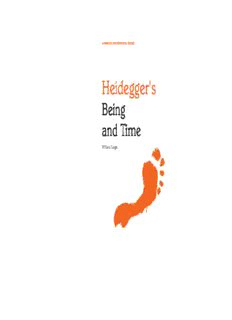
Heidegger's "Being and Time" (Edinburgh Philosophical Guide) PDF
Preview Heidegger's "Being and Time" (Edinburgh Philosophical Guide)
H EDINBURGH PHILOSOPHICAL GUIDES e EDINBURGH PHILOSOPHICAL GUIDES General Editor: Douglas Burnham id e The books in this series are specifically written for students reading g philosophy for the first time. Focusing on passages most frequently taught g at university level each book is a step-by-step guide to help you read the e key texts from the history of philosophy with confidence and perception. r ' Each book offers: s (cid:127) a summary of the text Heidegger's B (cid:127) an overview of its key ideas e (cid:127) historical context in (cid:127) a guide to further reading and study g a Being n d T Heideggers's Being and Time i m and Time William Large e ‘As the first commentary on Being and Timein English to give as much respect to French readings of the book as to analytic readings, William Large's accessible Introduction deserves to be widely read.’ Robert Bernasconi, The University of Memphis William Large Everything you need to know about Heidegger’s Being and Time in one volume. Being and Timeis one of the most important publications in phenomenology of the twentieth century which has had a direct influence on not only many W dtoif ffeirrsetn-tti mphei lroesaodpehrse rosf, Hbuetid aelsgog earr taisntds, isw frriteeer so af ntedc hfilnmic mal ajakregrosn. .T Rhiesa bdoeorsk appeals illia m will be taken through Being and Time section by section, meaning it can be L read alongside the main text. ar g e William Large is a Senior Lecturer in Philosophy at the College of St Mark and St John. He also teaches political theory at Exeter University. ISBN 978 0 7486 2734 9 Edinburgh University Press E 22 George Square d i Edinburgh n b EH8 9LF u www.eup.ed.ac.uk r g Cover design: designforpublishing.co.uk h Heidegger’s Being and Time Edinburgh Philosophical Guides Series Titles in the series include: Kant’sCritique of Pure Reason Douglas Burnham with Harvey Young Derrida’sOf Grammatology Arthur Bradley Heidegger’sBeing and Time William Large Descartes’Meditations on First Philosophy Kurt Brandhorst Husserl’sThe Crisis of European Sciences and Transcendental Phenomenology Katrin Joost Plato’sRepublic Darren Sheppard Spinoza’sEthics Beth Lord Heidegger’s Being and Time An Edinburgh Philosophical Guide William Large Edinburgh University Press © William Large, 2008 Edinburgh University Press Ltd 22 George Square, Edinburgh Typeset in 11/13pt Monotype Baskerville by Servis Filmsetting Ltd, Manchester, and printed and bound by Antony Rowe Ltd, Chippenham, Wilts A CIP record for this book is available from the British Library ISBN 978 0 7486 2733 2 (hardback) ISBN 978 0 7486 2734 9 (paperback) The right of William Large to be identified as author of this work has been asserted in accordance with the Copyright, Designs and Patents Act 1988 Contents Series Editor’s Preface vii Acknowledgements ix Abbreviations xi Introduction 1 1. Historical Context 3 From Phenomenology to Ontology 3 2. A Guide to the Text 19 The Question of Being 19 Being-in-the-World 34 Others, Language and Truth 51 Anxiety, Death and Guilt 66 Time and History 83 3. Study Aids 105 Glossary 105 Further Reading 127 Writing an Essay on Heidegger’s Being and Time 139 Index 147 Series Editor’s Preface To us, the principle of this series of books is clear and simple: what readers new to philosophical classics need first and foremost is help with readingthese key texts. That is to say, help with the often antique or artificial style, the twists and turns of arguments on the page, as well as the vocabulary found in many philosophical works. New readers also need help with those first few daunting and disorienting sections of these books, the point of which are not at all obvious. The books in this series take you through each text step-by-step, explain- ing complex key terms and difficult passages which help to illustrate the way a philosopher thinks in prose. We have designed each volume in the series to correspond to the way the texts are actually taught at universities around the world, and have included helpful guidance on writing university-level essays or examination answers. Designed to be read alongside the text, our aim is to enable you to read philosophical texts with confidence and per- ception. This will enable you to make your own judgements on the texts, and on the variety of opinions to be found concerning them. We want you to feel able to join the great dialogue of philosophy, rather than remain a well-informed eavesdropper. Douglas Burnham Acknowledgements The writing of this book was supported by a research grant from the University College Plymouth, St Mark and St John, for which I am very grateful. I would also like to thank the series editor Douglas Burnham and Carol Macdonald the commissioning editor from Edinburgh University Press for their patience and helpful advice. Finally I would like to thank my friends and colleagues who read different versions of this manuscript: Arthur Bradley, Paul Bentley, Rob Brown, Lars Iyer, Meredith Millar, Val Reardon, Paul Sutton and David Webb.
Description: